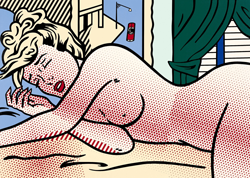1994–97
Like Pablo Picasso and Henri Matisse before him, Lichtenstein returned to the motif of the female form late in life. He engaged this enduring arthistorical subject in provocative ways with his Nudes of the mid-1990s. Unlike traditional depictions based on live models, these women are inventions. Their origins can be traced to the artist's archive of comicbook clippings, some dating back to the 1960s. While his sources were most often altered to achieve greater compositional clarity, here there is one key difference: the originally clothed heroines are now undressed. In early Pop works, the artist crafted scenes from a single cartoon panel; in this series, the works are often a composite of women drawn from multiple panels. The results can appear, as in Nudes with Beach Ball (1994) or Two Nudes (1995), purposely disjunctive. Furthermore, the artist typically deployed his trademark version of painted Benday dots to mimic chiaroscuro, traditionally used in painting to represent volume and dimension. Here, however, they are used to create unreal contrasts in the illumination of forms. Transgressing the limits of the nude's curvilinear torso, Lichtenstein's dots cascade from the top to the bottom of the canvas, breaking the conventional distinctions of foreground and background and thereby flattening the picture plane. The artist had used this novel technique before (for example, in the Mirrors paintings on view in a previous gallery). In this series, the strategy creates spatial ambiguities, with the human figure as the principal foil.
The last work in the series, Interior with Nude Leaving (1997), not only depicts the departure of the female form, but also announces a change in the artist's graphic style. Lichtenstein's trademark black contour lines recede, and the emphatic articulation of forms in space begins to dissolve. This late work points to new developments in Lichtenstein's thinking about painting and to the potential for further innovation.
Roy Lichtenstein. Nude with Street Scene, 1995. © Estate of Roy Lichtenstein. Collection Simonyi.

